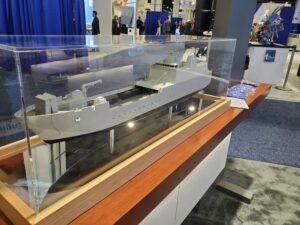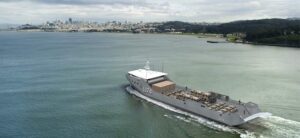SAN DIEGO – Marine Corps officials here this week explained the service’s amphibious force requirements calls for 35 new Medium Landing Ships (LSM), formerly called the Light Amphibious Warship (LAW), based on spacing and cargo requirements.
A minimum 35 LSMs and 31 traditional amphibious warships is “the minimum number required. That’s based on some virtuous and righteous research, data and experimentation and wargaming. It’s also based on the fact that, per the guidance from our Secretary of the Navy, we have to ensure that our Marines have the tools, the ships, to train with, and our sailors have the ships to train with. Because you don’t want the first time you go out the door to war…that should not be the first time that a young first lieutenant is landing a [CH-53K] or an Osprey on the deck of a pitching, rolling amphib,” Gen. Eric Smith, Assistant Commandant of the Marine Corps (ACMC), said here Wednesday during the annual WEST conference, sponsored by AFCEA International and the U.S. Naval Institute.

Smith said they need enough amphibious ships so that the training in peacetime becomes rote “because that’s part of organic mobility.”
He argued this organic mobility is needed to keep the Marine Corps ready to move and operate with partners from a position of advantage, in case a conflict erupts in a place like the Western Pacific.
“If you don’t have organic mobility, then you’re just waiting in line waiting for stratlift, like everybody else…It has to be affordable because you have to produce it in quantity because that is your organic mobility with limited days of warning, you move key points to key elements to strategic points, predetermined points,” the ACMC continued.
Smith said the requirement for LSMs is specifically set at 35 vessels because they need nine vessels for each of the three Marine Littoral Regiments (MLR).
According to a new Marine Corps video, the 35 total LSMs will ensure 27 ships are available for the MLRs at any given time while accounting for eight ships with routine maintenance cycles.
The video also said the LSM “will allow Marines to rapidly and efficiently move throughout the battlespace to sense and make sense of adversary actions and provide valuable intelligence to commanders. They are critical to modernizing legacy pre-positioning capability into a dynamic integrated afloat ashore network that is ideal for intra-theater, small scale distribution and sustainment and will complement the actions of the larger Navy and joint force.”
Another official elaborated on how the number of nine LSMs per MLR was based on space requirements.
The Navy had done “extensive modeling and simulation of what it requires to support a regiment. Doesn’t necessarily mean it needs to be a littoral regiment, it’s just a regiment. So the square footage, the cargo and that’s where we came up with the requirements. Berthing, fuel, all of it,” Lt. Gen. Karsten Heckl, Commanding General of the Marine Corps Combat Development Command and Deputy Commandant for Combat Development and Integration, said during a panel on Wednesday.
He argued the MLR is “simply another flavor” of a Marine Air Ground Task Force, so they have the data for how much square footage and tonnage is required to support that kind of regiment in an amphibious environment.
Heckl argued the MLR is needed because “there will be some things that will require surface lift…and the real strength in that thing is it has to be shore to shore. The days of offloading in Iron Mountain in Kuwait, or in Saudi Arabia in preparation for the breach – I don’t think are going to be happening anymore, particularly the Indo-Pacific. So the Marines will not be pier dependent. We’re not going to be a big 12,000 foot runway dependent – we need shore-to-shore maneuver. And that’s what the LSM brings.”
Heckl also said why the Marine Corps says it needs 35 LSMs, but Chief of Naval Operations Adm. Mike Gilday’s June 2022 navigation plan (NAVPLAN) calls for 18 vessels (Defense Daily, June 26, 2022).
Heckl said he and Vice Adm. Scott Conn, deputy chief of naval operations for warfighting requirements and capabilities (OPNAV N9), crafted that language together so the final requirement is 35 ships, but 18 are an “initial operational inventory.”

In January, Marine Brig. Gen. Marcus Annibale, director of expeditionary warfare (OPNAV N95), said the NAVPLAN goal of 18 LSM/LAW goal will be locked in for the FY ‘25 budget planning as an initial capacity. At the time, Annibale also said the 35-ship Marine Corps red line could mean beyond 18 LSMs the service uses a mix of other craft to reach that 35-ship goal (Defense Daily, Jan. 17).
Smith said the service hopes to start producing LSMs around fiscal year 2025 to 2026. This comes after the FY 2023 budget request said the initial ship procurements were being pushed back from FY 2023 to 2025 (Defense Daily, March 30, 2022).
The Marine Corps video noted LSM fielding is not expected to start until 2029.
In the meantime, the Marine Corps is using a “bridging solution” that entails leasing one stern landing vessel (SLV) with options for two more to experiment with the concept. The Navy is also using Spearhead-class Expeditionary Fast Transports (EPF).
Last year, Marine Corps officials said it contracted with Hornbeck Offshore Services to experiment with the SLVs.
Smith reiterated SLV testing is not for the larger concept, but specific details for the stand-in force.
“The lessons learned using the stern landing vessel will be valuable in developing the final requirements for the LSM.”
The Navy previously said the LSM/LAW is expected to be 200 to 400 feet long., able to transport up to 75 Marines and their gear each, travel upward of 3,500 nautical miles and carry up to 10,000 square feet of cargo.